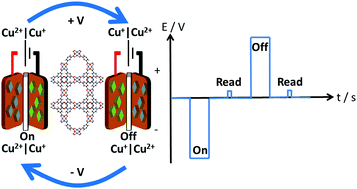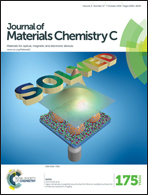Facile fabrication of metal–organic framework HKUST-1-based rewritable data storage devices†
Abstract
Metal–organic framework (MOF) HKUST-1 coated Cu electrodes synthesised by a quick and scalable anodic dissolution process and assembled into a sealed, symmetrical, two electrode coin cell configuration are shown to demonstrate redox-based data storage behaviour. The observed behaviour is confirmed to be definitively due to the HKUST-1 itself as opposed to the underlying Cu/CuO electrode surface by demonstration of the same effect using HKUST-1/PVDF composite coated carbon fibre electrodes. This data storage behaviour is attributed to the immobilisation of a fixed number of electrically accessible Cu cations within the porous HKUST-1 framework that are in the vicinity of the electrode surfaces and their ability to undergo facile Cu2+/+ redox interconversion as a function of the potential applied across the electrodes. This proposed redox-based mechanism for the observed data storage effect has never previously been reported for MOF-based devices. Optimisation of electrolyte composition, electrolyte concentration and electrode separation results in “on”/”off” current densities of the order of 1 mA cm−2, an “on” : “off” ratio of ∼5, “on”/”off” states stable to at least 10 consecutive reads, rewritability that persists over 6000 cycles, and the storage of data that can still be read hours after writing. The resulting data storage devices are more stable to successive reading and can be rewritten many more times than other previously reported pure MOF-based devices.



 Please wait while we load your content...
Please wait while we load your content...